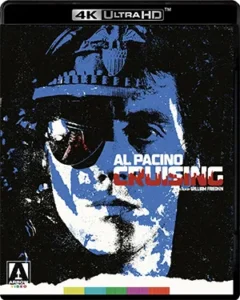
Cruising, once denounced as homophobic pulp, is now being reassessed as a daring exploration of performance, identity, and the psychic costs of repression.
 Cruising William Friedkin Arrow 24 February 2025
Cruising William Friedkin Arrow 24 February 2025
When Cruising was released in 1980, it was reviled. Protested by the gay community, dismissed by critics, and largely ignored by awards bodies, it was seen as exploitative and grotesque. Yet today it stands as one of William Friedkin’s most provocative and enduring works: a film whose ambiguity, physicality, and bold aesthetic choices mark it as an original. What was once denounced as homophobic pulp is now being reassessed as a daring exploration of performance, identity, and the psychic costs of repression.
Like much of Friedkin’s work, Cruising disorients, alienates, and stares unflinchingly at things most directors wouldn’t dare touch. What was once shouted down has, decades later, become essential viewing in courses on queer cinema, urban alienation, and cinematic transgression.

Our Amorphous Identities
We must descend into its darkness to understand what makes Cruising so charged and challenging to watch. This erotic thriller is ostensibly about an undercover cop (Steve Burns, played by Al Pacino) investigating a series of murders in the S&M/leather bar gay subculture in New York. As such, Cruising is yet another Friedkin film with the utmost commitment to the world it creates.
Friedkin’s The Exorcist (1973) doesn’t flinch from the darkness it invokes. It creates a sophisticated, urbane Georgetown world and systematically destroys its philosophical underpinnings. (The Iraq scene at the start is sheer genius. Here is a world that does not recognise yours, for which you are a mere blip, if you appear on the radar at all. You are physically and psychologically decentered.)
With The French Connection (1971), Friedkin was so obsessed with capturing the grimy New York streets that no set was built. This cop drama was filmed on location, without permits. The texture and grit of the urban scenes are utterly unimprovable.
The corruption of the Reagan-era 1980s and Los Angeles has rarely been better exposed than in 1985’s To Live and Die In L.A. Bright, unblinking, unshadowed, everything is clear. Money is everything in this film, but money is fake. Everything is a rip-off. While 1977’s Sorcerer may be slow to get into gear, its scenes in South America are some of the most brutally physical ever filmed.
Cruising, meanwhile, is an exploration of a subculture, a slasher movie, a study of amorphous identity, and a police procedural. Most vividly, it lays out the rules of NYC’s leather bar subculture with a keen eye for psychogeography. The clubs are exposed with brutal clarity as sites of ritualised need. There’s no ambiguity about desire: it’s given a clear language through the hanky code and the highly stylised leather and police costumes. It’s transactional, perhaps, but the costs are low: no flirtation-as-performance, no prolonged ambiguity, just the raw economics of need; immediate, bodily, clear.
Few films are as grindingly physical as Cruising. You’ll see a lot of male buttocks. We’re not talking tanned, oiled, and muscular buttocks. We’re talking hairy, pallid, spotty bums. Most directors would balk at such a realistic depiction, but to his credit, Friedkin never flinches. (He did have a 12-year-old violently masturbating with a crucifix in The Exorcist, after all.)
Something Is ‘Off’ in Cruising
The ambiguities in Cruising are multiple and intentional. Several directorial choices create a sense of dissociation. The dubbing is notably bad, primarily but not exclusively, when the killer (Stuart Richards, played by Richard Cox) speaks, such as when he says, “You made me do that.” At first, I thought Friedkin had a bad sound guy, but he knows what he’s doing. Some voices are a bit off because the characters are not vocalising their true selves. You’re watching a performance of a performance. You begin to wonder if anyone is who they seem. Subtle, huh?
It’s the same with the music in the club scene. It never quite matches: it fits the visual tempo (dancing, high-energy rock music, etc), but not the emotional tone. It’s just off enough to feel jarring. That disjunction suggests an alienation even during Steve’s absorption into the leather culture in the poppers scene, where the film finally blazes with colour after it had been so blue and cold. This filmic method suggests the synthetic in identity, as performance.
It’s remarkable how willing Friedkin is to alienate the audience. He could have played killer rock or disco songs and had everyone nodding as Steve assimilated himself. Yet he holds something back, to alienate Cruising‘s viewers and make them understand, “This is not real.”
Similarly, there are multiple suggestions that there is more than one killer. This might alienate those who prefer the geometric plotting of slasher movies (notice the killer-find the killer-catch the killer), but it reinforces Cruising‘s alienating theme. Identity is uncertain. The killer may yet walk among us. Most disturbingly, the killer may in fact be us.
This is why the club setting in Cruising is so effective. With masks, you can hide, but you can also reveal your true self. As Oscar Wilde said in The Critic As Artist (1891), “Man is least himself when he talks in his own person. Give him a mask, and he will tell you the truth.”
Our Perpetual Performances
Perhaps the deeper, and more disturbing idea in Cruising is that we have no essential self. The self is social and reciprocal. We adapt to others. So the performativity of personality, the fact that we contain multitudes, is demonstrated throughout.
Cruising opens with two openly homophobic cops harassing transvestite sex workers, making bad jokes about “cork soakers”. Then one cop demands oral sex from one of the guys, because nothing affirms his manhood like a blowjob from someone he just dehumanised. Later on, we see the other cop in the leather bar, his eyes raging with lust. He, too, is more than he let on.
Of course, the bars are a place of identity cosplay. The ironies multiply when Steve, an undercover cop, is thrown out of “Precinct Night”, when the attendees dress as cops and have fun with nightsticks. He is wearing the wrong uniform. Costume can be identity (as in job and economic status) but can also be ironized, stylized, and toyed with.
Steve has yet to learn. When he initially flaunts a yellow hankie in his back pocket, he enrages a patron who acts upon this signifier by turning him down. He has broken the code. Yet, he learns. Friedkin employs the time-honoured technique of a montage to show Steve developing muscle, building connections with bartenders, putting on eyeliner, and donning black clothes.
Cruising‘s famous ending – where his fiancée (played by Karen Allen) dons the leather cap and mirrored sunglasses – is the final pull of the rug. Even the person who symbolised certainty and stability may have unexplored depths. Because – don’t we all?
This suggestion that sexuality is fluid is a founding idea of queer culture, which makes it all the more ironic that Cruising was subject to protests from the gay community, which argued that film conveyed gay culture as sick, its community a place criminality, and that it exploited the gay community as a prop to shock heterosexual audiences. One can appreciate the response – They finally make a film about gay culture, and they make us serial killers? – But this entirely misreads the film because Cruising is not really about gay culture at all.
Cruising Asks ‘Who Are You?
With Cruising, Friedkin conveys that in performative cultures, we can hide if we play a role. The choice of S&M subculture becomes clear when seen through this lens. It’s not saying that gay people are sick or decadent. It’s telling that identity is a costume we learn to wear, so Friedkin selected the most stylised and performative of all subcultures to explore that. It was a brave choice; we got a film documenting an 1980s-era subculture. It was a subculture built on extremity, clarity, and need. It didn’t seek assimilation or acceptance.
Cruising may not be perfect (as a slasher movie, it’s quite lacking, for example), but it captures that scene with a rawness and courage no one else dared. Today, when identity is curated more than lived, dating is algorithmic, and gay sex is pursued digitally rather than in physical, communal spaces, Cruising feels almost shockingly alive.
Cruising is about much more than one subculture: it’s about human identity and performance. We are actors in the dramas of our own lives, it says. As sociologist Erving Goffman argues in The Presentation of Self in Everyday Life (1956), the self is not something we possess but perform; it’s a fragile construct shaped by the stages in which we find ourselves. “When an individual presents himself before others, his performance will tend to incorporate and exemplify the officially accredited values of the society… He will be required to entrust his self-image to their tender mercies,” writes Goffman.
Cruising captures this unsettlingly: not just hidden desires, but the dance of being. Who we are depends on who’s watching and which role we think they’ll accept. So the answer to the question, “Who are you?” is really, “Who’s asking?”


